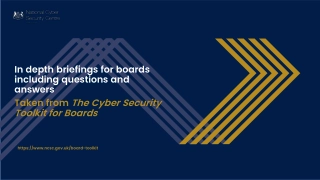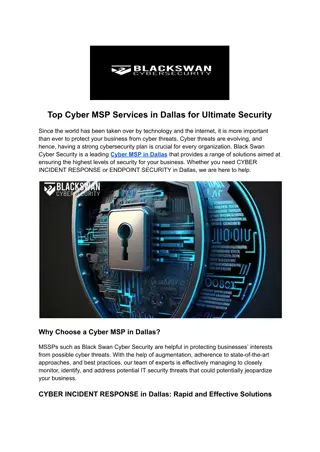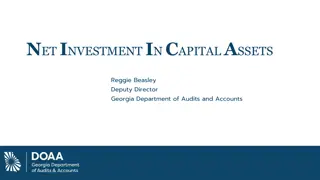Safeguarding Information Assets from Cyber Threats
Explore the world of protecting information assets with insights on various types of threats and computer crimes, understanding attackers, attack methods, persistent electronic threats, DDoS attacks, bot-net concepts, and utilizing reCAPTCHA for input validation. Gain knowledge on safeguarding against theft, fraud, sabotage, and more in the digital realm.
Uploaded on Nov 21, 2024 | 1 Views
Download Presentation

Please find below an Image/Link to download the presentation.
The content on the website is provided AS IS for your information and personal use only. It may not be sold, licensed, or shared on other websites without obtaining consent from the author.If you encounter any issues during the download, it is possible that the publisher has removed the file from their server.
You are allowed to download the files provided on this website for personal or commercial use, subject to the condition that they are used lawfully. All files are the property of their respective owners.
The content on the website is provided AS IS for your information and personal use only. It may not be sold, licensed, or shared on other websites without obtaining consent from the author.
E N D
Presentation Transcript
Chap 11 : Protecting Information Assets Dr. Ir. Yeffry Handoko Putra, M.T Magister Sistem Informasi Universitas Komputer Indonesia
Recognizing Types of Threats and Computer Crimes Theft Fraud Sabotage Industrial Espionage Unauthorized Disclosure Loss of Credibility Loss of Proprietary Information Legal Repercussions
Identifying the Perpetrators Hackers Crackers Script Kiddies Employee Betrayal Ethical Hacker Gone Bad
Understanding Attack Methods Passive Attacks network analysis traffic analysis Eavesdropping Active Attacks Social Engineering Phishing Spear Phishing Dumpster Diving
Persistent Electronic Threats Malware Trojan Horse Virus Internet Worm Logic Bomb Time Bomb Trapdoor Root Kit Brute Force Attack Denial of Service (DoS) Distributed Denial of Service (DDoS) IP Fragmentation Attack Crash-Restart Maintenance Accounts Robot Networks Programming Vulnerability Cross-Site Scripting (XSS) Middleware Attack Zero-Day Attack Remote Access Attack
Using reCAPTCHA for input validation to reduce automated submission
Typical implementation of middleware in computer programming
Other attack Source Routing Salami Technique Packet Replay Message Modification Email Spamming and Spoofing
Implementing Administrative Protection Formal organizational reporting structure with accurate job descriptions (maintained by HR for all personnel including contractors) Physical and environmental protection of IT assets Classification of data in the organization s possession (by value, type, or risk threshold) Records management policy (based on ISO 15489 with IT backup/restore functions) Access control policy (all data, all departmental functions across the organization) Personnel security policy (maintained by HR) Identification and authentication policy (authorized users, devices, program access) Security planning policy with capital budgeting (created by the steering committee with input from IT and Finance) Risk assessment policy focused on the likelihood of occurrence or consequence of loss System and services acquisition policy (by Procurement) System protection policy (by Legal, CFO, and IT for all computing devices)
Implementing Administrative Protection Communications protection policy (governing all connected networks, IT, ISP, and telcom provider) Configuration management policy (by Quality, mandatory change control) Acceptable use policy (maintained by HR) Computing/communications maintenance policy (for systems and devices) Media protection policy (print, electronic, CD, HDD, tape, portable drives, and so forth) Telecommuting policy (for remote workers) Network connection and data sharing with business partners (Legal, IT, internal audit) Contingency planning policy (driven by program office, business unit subcomponents) Incident response policy (HR, Legal, law enforcement, Facility, and IT components) Audit and accountability policy (executive audit committee, internal audit) Security assessment mandating use of specific technical certification procedures (prerequisite to management accreditation) policy (governing all connected networks, IT, ISP, and
Proper Data Classification Classified Unclassified For example, credit card data requires special security with partial records destruction of account number segments and account authenticators in accordance with payment card industry (PCI) standards. To violate the PCI standards could bring forfeiture of merchant privileges plus civil and criminal liability
Technical Control Classification using a combination of mandatory controls or discretionary controls. Mandatory Access Controls Discretionary Access Controls Role-Based Access Controls Task-Based Access Controls Attribute-Based Access Controls
Application Software Controls Database views for security Restricted User Interface Security Labels
Authentication Methods login ID and password PIN. Using Biometrics Fingerprint - Palm Print - Retina scanning Face Scan
Network Access Protection Kerberos Single Sign-On Network Firewalls
firewall technology First Generation: Packet Filter The first generation was a packet filter. Filtering is based on the sending and receiving address combined with the service port (a packet). The advantage of this design is its low cost.
firewall technology Second Generation: Application Proxy Filter A firewall application program was added to the first- generation design of packet filtering. The second generation uses an application proxy to relay requests through the firewall. The proxy checks the inbound request to ensure that it complies with safe computing in both format and type of request. Application proxies perform user requests without granting direct access to the target software
firewall technology Second Generation: Application Proxy Filter
Third Generation: Stateful Inspection Fourth Generation: Adaptive Response Fifth Generation: Kernel Process
four types of VPN technology Point-to-Point Tunneling P NN rotocol, or PPTP Layer 2 Tunneling Protocol, or L2TP (OSI layer 2, Data- Link) Secure Sockets Layer, or SSL (OSI layer 5, Session) Internet Protocol Security, or IPsec (OSI layer 3, Networking























